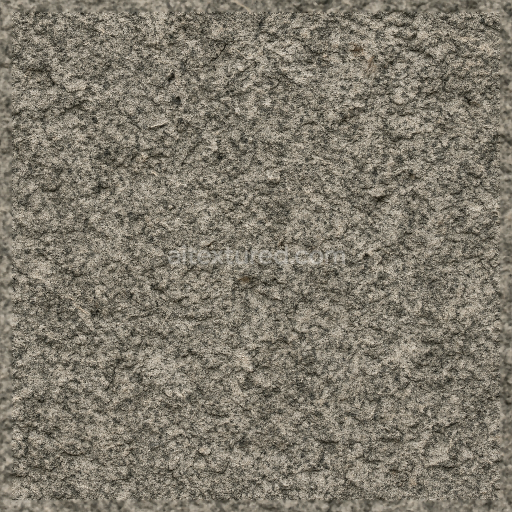This seamless 3D texture presents an 8K resolution portrayal of granite, a coarse-grained igneous rock primarily composed of quartz, feldspar, and mica. The texture reveals the natural crystalline structure typical of granite, with interlocking mineral grains creating a dense, pebbled surface. The rough stone appearance reflects a naturally weathered rock face, showcasing subtle variations in grain size and mineral composition. The form is irregular and granular, mimicking a rugged stone wall or exposed rock face, with no repetitive patterns to disrupt realism. The surface finish is matte and unpolished, emphasizing the raw, natural state of granite as found in outdoor environments.
From a material perspective, granite’s substrate is a solid mineral matrix where quartz provides hardness and translucency, feldspar contributes to the overall color palette with shades ranging from light pinks to grays, and mica adds flecks of reflective sheen. This crystalline aggregate results in a texture with moderate porosity, revealing fine fissures and crevices caused by natural weathering. The texture’s PBR maps accurately capture these features: the BaseColor (Albedo) channel conveys the subtle color variations and mineral speckles; the Normal map defines the intricate grainy relief and pebbled topography; Roughness emphasizes the matte, uneven surface reflecting light diffusely; the Metallic channel is minimal, consistent with granite’s non-metallic nature; Ambient Occlusion enhances depth perception in crevices; and Height/Displacement maps provide realistic depth for enhanced parallax effects in 3D applications.
Designed for seamless tiling, this texture allows continuous application across large surfaces without visible seams, making it ideal for architectural visualization, game environments, or digital artwork requiring authentic stone materials. Its 8K resolution ensures exceptional detail and fidelity, suitable for close-up renders and high-quality outputs. The texture is optimized for use in Blender, Unreal Engine, and Unity, supporting complex PBR workflows and real-time rendering pipelines.
For practical usage, it is advisable to carefully adjust the UV scale to maintain the natural grain size of granite without exaggeration, preserving realism. Additionally, fine-tuning the roughness map can help simulate different weathering states, from freshly exposed rough stone to more eroded, smoother surfaces. Combining height and normal maps in shader settings enhances the perception of depth and complexity on rock faces, especially when viewed at shallow angles, adding to the material’s authenticity in 3D scenes.
How to Use These Seamless PBR Textures in Blender
This guide shows how to connect a full PBR texture set to Principled BSDF in Blender (Cycles or Eevee). Works with any of our seamless textures free download, including PBR PNG materials for Blender / Unreal / Unity.
What’s inside the download
*_albedo.png — Base Color (sRGB)*_normal.png — Normal map (Non-Color)*_roughness.png — Roughness (Non-Color)*_metallic.png — Metallic (Non-Color)*_ao.png — Ambient Occlusion (Non-Color)*_height.png — Height / Displacement (Non-Color)*_ORM.png — Packed map (R=AO, G=Roughness, B=Metallic, Non-Color)

Quick start (Node Wrangler, 30 seconds)
- Enable the addon: Edit → Preferences → Add-ons → Node Wrangler.
- Create a material and select the Principled BSDF node.
- Press Ctrl + Shift + T and select the maps
albedo, normal, roughness, metallic (skip height and ORM for now) → Open.
The addon wires Base Color, Normal (with a Normal Map node), Roughness, and Metallic automatically.
- Add AO and Height using the “Manual wiring” steps below (5 and 6).
Manual wiring (full control)
- Create a material (Material Properties → New) and open the Shader Editor.
- Add an Image Texture node for each map. Set Color Space:
- Albedo → sRGB
- AO, Roughness, Metallic, Normal, Height, ORM → Non-Color
- Connect to Principled BSDF:
albedo → Base Colorroughness → Roughnessmetallic → Metallic (for wood this often stays near 0)normal → Normal Map node (Type: Tangent Space) → Normal of Principled.
If details look “inverted”, enable Invert Y on the Normal Map node.
- Ambient Occlusion (AO):
- Add a MixRGB (or Mix Color) node in mode Multiply.
- Input A =
albedo, Input B = ao, Factor = 1.0.
- Output of Mix → Base Color of Principled (replaces the direct albedo connection).
- Height / Displacement:
Cycles — true displacement
- Material Properties → Settings → Displacement: Displacement and Bump.
- Add a Displacement node: connect
height → Height, set Midlevel = 0.5, Scale = 0.02–0.08 (tune to taste).
- Output of Displacement → Material Output → Displacement.
- Add geometry density (e.g., Subdivision Surface) so displacement has polygons to work with.
Eevee (or lightweight Cycles) — bump only
- Add a Bump node:
height → Height.
- Set Strength = 0.2–0.5, Distance = 0.05–0.1, and connect Normal output to Principled’s Normal.
Using the packed ORM texture (optional)
Instead of separate AO/Roughness/Metallic maps you can use the single *_ORM.png:
- Add one Image Texture (Non-Color) → Separate RGB (or Separate Color).
- R (red) → AO (use it in the Multiply node with albedo as above).
- G (green) → Roughness of Principled.
- B (blue) → Metallic of Principled.
UVs & seamless tiling
- These textures are seamless. If your mesh has no UVs, go to UV Editing → Smart UV Project.
- For scale/repeat, add Texture Coordinate (UV) → Mapping and plug it into all texture nodes.
Increase Mapping → Scale (e.g., 2/2/2) to tile more densely.
Recommended starter values
- Normal Map Strength: 0.5–1.0
- Bump Strength: ~0.3
- Displacement Scale (Cycles): ~0.03
Common pitfalls
- Wrong Color Space (normals/roughness/etc. must be Non-Color).
- “Inverted” details → enable Invert Y on the Normal Map node.
- Over-strong relief → lower Displacement Scale or Bump Strength.
Example: Download Wood Textures and instantly apply parquet or rustic planks inside Blender for architectural visualization.
To add the downloaded texture, go to Add — Texture — Image Texture.

Add a node and click the Open button.

Select the required texture on your hard drive and connect Color to Base Color.


